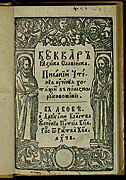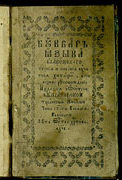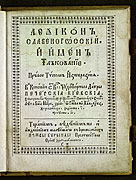A. Voznesensky
16th-17th Century ABC Books, Grammars and Dictionaries
Texbooks for Teaching Reading, Published in the Grand Duchy of Lithuania
In the lands of the Grand Duchy of Lithuania, like in Moscow, ABC books were primarily published in the written language, but there, in contrast to Moscow, was not the one but two book languages: Church Slavonic and "Russian", as priters themselves called it, or so-called "plain speech". So, already on the front page of their language manuals, the south-western Russian printers had to indicate exactly with what kind of language they dealt, and this tradition continued at least during the 17th century (No. 16, No. 17, No. 18, No. 19, No. 20).
The Church-Slavonic language was used for worship services, while "plain Russian" served to talk over temporal affairs. Such the separation between the two languages, however, did not prevent them being used at the same time at the same book, but their application has always been regulated. Thus, judging by its title, the Grammar of the Slavonic Language by pseudo-Damascus, printed in Vilna (now Vilnius) in 1586, belongs to the landmarks of the Church Slavonic language, although it includes Latin marginalias (No. 21), besides, the publisher's information is written in "plain speech" (No. 22).
It should be noted that, in the south-western Russia, Primers and Grammars were published only in one of the two languages: Church Slavonic. And the explanation, it seems, lies in the fact that most of the publications in Cyrillic were liturgical books. Meanwhile, Church Slavonic was already difficult to understand in the Lithuanian lands. It is not by chance, after issuing the Slavonic Grammar (No. 23)back in 1596, Lawrence Zizany immediately hastened to publish the book entitled Science of Reading and Understanding of Slavonic Writing (No. 24).
The Science includes the most elementary ABC, Lexis - a dictionary compiled by Lawrence Zizany, in which Church Slavonic words were translated into "plain Russian" (No. 25), and the Statement of the Orthodox Faith by Stephen Zizany, i.e. a short catechism.Even more telling is the next example. When, in 1642 in Lviv, printers decided to publish the Instructions to a Newly Consecrated Priest supplemented with the work On the Sacraments of the Church in the Commonwealth by Sylvester Kossov (No. 26),they had by tradition to print the first part of the book in Church Slavonic. Therefore, the printers felt it necessary to accompany the text with 'The Explanation of the Most Incomprehensible Words Included in the Instructions'. That was a small dictionary arranged in alphabetical order, which transferred meanings of some words to the "plain speech" (No. 27). Remarkable is a note at the end of the Explanation, 'Try to find the rest in the Lexicon'(No. 28).
This note, no doubt, reads about the quite specific book - the Lexicon compile by Pamvo Berynda and issued in Kiev in 1627 at his own expense (No. 29). The appearance of the Lexicon seems to be caused by an increase in printing activity of the Kiev-Pechersk Monastery. In the 1620s, there were printed a number of not previously published books, very important for the Orthodox Church: all of them, by tradition, were in Church Slavonic. Pamvo Berynda, who was involved in the work of the Monastery's typography, could not ignore this fact, especially because, by that time, the Monastery had realized that the Church Slavonic language is incomprehensible to the common people. It is no accident that, the Triodion (the liturgical book used during Great Lent), issued in the same 1627 in Kiev, contained texts distinguished from the others by their language which was the "plain speech".
Notworthy that the Church Slavonic language was seen by Pamvo Beryndoy as poorly understood as Hebrew, Greek and Latin, he provides an explanation of words taken from the Bible in the supplement to the Lexicon (No. 30). It also should be noted that Berynda's book remained popular throughout many years: for instance, it was reprinted in the Kutein Monastery (now Belarus) in 1653 (No. 31).
Features of schooling in the south-western Russia influenced on the publication of a number of grammars which were intended to use for the next stages of learning following primary education. The first such book appeared in Lviv in 1591, it was published for teaching Greek to the young at a sister school (No. 32). Later, Slavonic Grammar compiled by Meletius Smotrytsky (No. 33) was printed in the Grand Duchy of Lithuania. The author considered it necessary to address its preface to school teachers and explain the aims of schooling as he sees them.






![Instructions to a Newly Consecrated Priest; [Sylvester Kossov]. On the Sacraments of the Church in the Commonwealth. Lviv, 1642 Instructions to a Newly Consecrated Priest; [Sylvester Kossov]. On the Sacraments of the Church in the Commonwealth. Lviv, 1642. Title page.](images/26_p.jpg)
